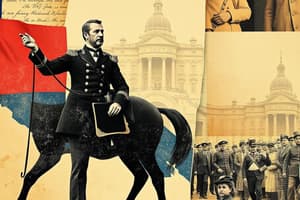Podcast
Questions and Answers
What was José Martí's initial view of the United States?
What was José Martí's initial view of the United States?
- He was indifferent towards the United States and focused solely on Cuba.
- He admired the United States as a model of freedom and dynamism. (correct)
- He was highly critical of American society and its racism.
- He saw the United States as a potential threat to Latin American independence.
How did Martí's role evolve during his time in the United States?
How did Martí's role evolve during his time in the United States?
- He abandoned his interest in Cuba and became fully integrated into American society.
- He focused more on lobbying the U.S. government to intervene in the Cuban conflict.
- He remained solely an observer and correspondent, reporting on American events.
- He transitioned from an observer to an active political actor working for Cuban independence. (correct)
What role did the Cuban cigar workers in Key West and Ybor City play in Martí's movement?
What role did the Cuban cigar workers in Key West and Ybor City play in Martí's movement?
- They provided financial support by contributing part of their wages to the cause. (correct)
- They served as Martí's personal security detail, protecting him from Spanish agents.
- They printed and distributed Martí's newspaper, _Patria_, across the United States.
- They acted as Martí's liaisons, lobbying the U.S. government for intervention in Cuba.
How did Martí view the growing power of the United States in relation to Latin America?
How did Martí view the growing power of the United States in relation to Latin America?
What was Martí's approach to seeking U.S. intervention in the Cuban conflict?
What was Martí's approach to seeking U.S. intervention in the Cuban conflict?
Flashcards are hidden until you start studying
Study Notes
Cuban Independence Struggle
- In 1868, Cubans rose in revolt against 300 years of Spanish rule.
- José Martí, a 15-year-old romantic and idealist, wrote his first poem inspired by the uprising.
José Martí's Early Life
- Martí was tried for treason and sentenced to forced labor for his involvement in the revolt.
- His mother pleaded for his release due to the severe lacerations from the chains on his legs.
- He was exiled from Cuba.
Martí in New York
- In 1880, Martí arrived in New York as a 27-year-old poet, seeking a safe place to plot for Cuban independence.
- He was drawn to the United States' ideals of equality and freedom.
- America offered intellectual freedom, allowing Martí to publish and explore alternative views of society.
Martí's Work in New York
- Martí worked as a correspondent for leading South American journals, covering various aspects of American life.
- He reported on significant events, including the opening of the Brooklyn Bridge and the Haymarket Square affair.
Martí's Disillusionment with America
- Martí's experiences with racism and inequality in the United States during the Jim Crow era and the age of robber barons disillusioned him.
- He began to question the US as a model for Cuba, envisioning a more inclusive and equal society.
Martí's Shift to Political Activism
- Around 1891, Martí became a full-time political actor, launching his vision for Cuban independence.
- He organized an insurrection from exile, rallying support among Cubans in Key West and Ybor City.
The Cuban Revolutionary Party
- Martí founded the Cuban Revolutionary Party and published a newspaper, Patria.
- He warned of the threat of American power to Latin America, advocating for Cuban independence and self-determination.
Studying That Suits You
Use AI to generate personalized quizzes and flashcards to suit your learning preferences.




